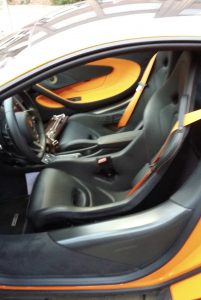The car manufacturer McLaren held an afternoon of talks by various engineers and designers for students interested in automotive engineering, discussing the development and production of luxury sports cars and showcased their P1 hybrid.
 McLaren is known for its Formula 1 involvement, but also produces three main tiers of cars (the Sports, Super, and Ultimate series), which use the same technologies as the England rugby team does in its shirts to monitor heart rates and temperature levels for analysing play. There are over 700,000 people working in the automotive industry in the United Kingdom, with it taking roughly two to three years from the initial design of a McLaren car to its production. There are around eight major steps along the way, with the third step (G3) being the sign-off point, meaning that the car has been cleared for manufacture.
McLaren is known for its Formula 1 involvement, but also produces three main tiers of cars (the Sports, Super, and Ultimate series), which use the same technologies as the England rugby team does in its shirts to monitor heart rates and temperature levels for analysing play. There are over 700,000 people working in the automotive industry in the United Kingdom, with it taking roughly two to three years from the initial design of a McLaren car to its production. There are around eight major steps along the way, with the third step (G3) being the sign-off point, meaning that the car has been cleared for manufacture.
Much earlier than this, however, SLS models have already been made for rapid prototyping, and to-scale clay models will have been made. One of the clay specialists showed us how these are finished to the highest level of detail — they are pieces of art within themselves! During development, McLaren uses a 3D design engineering package (Catia), and measures abuse loads with CAE (Computer Aided Engineering packages) as well as considering stamping feasibility i.e. where there will be too many stresses and strains on the mould.

An engineer explained how the hinges for dihedral doors worked, which consist of a body leaf, a door leaf, and a pin to connect the two, sounding quite simple, but taking around twenty minutes to explain. As seen in the pictures, the P1 has dihedral doors and is also made completely from carbon fibre, just like the Formula 1 cars. McLaren Special Operations (MSO) deals with personalising cars, where buyers can choose from a range of colours (or even have a custom one for a fee), and can opt for a signature or other engraving on the inside of the car, so that when the doors lift up, it becomes visible.

I was recommended the documentary “How to build a supercar”, and McLaren played their own marketing video about what it is like to work in automotive engineering. I found it quite amusing that they interviewed multiple female workers, but only a couple of male employees, yet shots of the office showed a very predominantly male workspace…

I personally do not strongly support people buying multiple sports cars that end up sitting in garages for nearly all the year, but did really enjoy the afternoon and especially loved looking at the engineering drawings. Formula 1, to me, is a waste of natural resources, but if the companies involved – like McLaren – are looking into a more sustainable future, then I hope that the general public will also become more interested in creating environmentally friendly automobiles.

